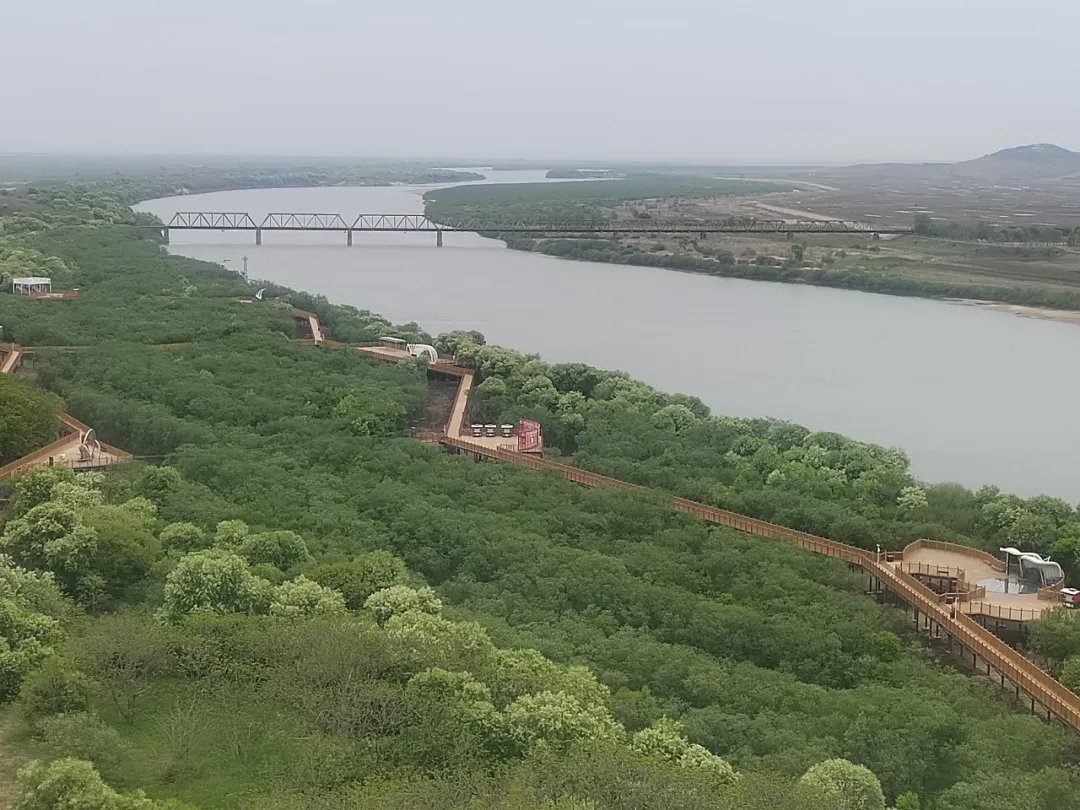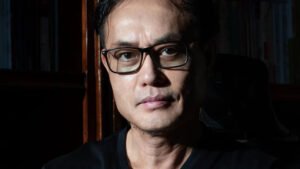
As the last interview of the series “New Voices of Northeast China” jointly launched by ARTBDL and the Northeast Asian Art Archive, our conversation with Professor Song Nianshen from the Institute of Humanities and Social Sciences and the Department of History at Tsinghua University might carry a slightly “intrusive” tone.
Song Nianshen, a native of Beijing, had never had any connection with Northeast China in the first 29 years of his life. It wasn’t until the early 21st century, when he went to the Sino-Korean border as a journalist for an interview, that he inadvertently stepped into the universe of the Northeast and never got out again. The year after that interview, Song Nianshen “accidentally” transitioned into the academic path of history research. His master’s and doctoral thesis in the UK focused on the Sino-Korean border in the Northeast, and his academic journey thereafter was consistently immersed in the continuous exploration, observation, and study of Northeast China. Starting from Goguryeo and the Tumen River, Song Nianshen marveled at the stark contrast between the reality of the border and his imagination, while discovering the fluidity and dispersion of the border. With the help of specific individuals, maps, fur, or streets from the border, he returned to historical scenes, striving to depict the Northeast’s turbulent history stirred by the wills of different countries at different times, while also identifying the subjectivity of the borderlands and their inhabitants.
The fruits and rewards of investing in the Northeast have undoubtedly been fruitful as well, and in May alone, Song Nianshen’s has published two new books, “Discovering East Asia” and “Mapping Asia: A History on the Map,” with another one ready to be published.
Coincidentally, shortly before our interview, Song Nianshen had just traveled to the Sino-Korean border to retrace the route he took 21 years ago. It was on the way that he suddenly realized: this is a farewell trip. His research on the Sino-Korean border should perhaps stop here. He hoped that his academic gaze could start from the Northeast border and go to farther, more distant borderlands and wider fields of writing.
Regardless of whether his writing extends to Mongolia or Inner Asia, Song Nianshen is acutely aware that the Northeast remains the starting point of everything. He has walked the route of the Sino-Korean border countless times, yet each time brings new feelings and discoveries. “The more I come into contact with it, the deeper my understanding becomes, and the Northeast transforms into something akin to a homeland—so close that it’s hard to speak about it.” When Song Nianshen said this, he revealed a rare moment of emotion in the entire interview. Most of the time, he approached the questions with the caution, self-restraint, and rigor of a historian, while also dispelling the binary thinking and intellectual laziness that often lie behind these questions. Facing disputes and conflicts, prejudices and barriers, Song Nianshen seeks transcendence—returning to historical sites to find real answers in the subtle and complex details. It’s not a matter of either/or, nor a zero-sum game, but rather a new possibility hidden within the gaps of history.

The Scene of History
Your academic path began with an in-depth tour of the Northeast, yet it seems to have never taken the Northeast as a whole concept and object, but rather included it in the broader frameworks of borders, East Asia, Northeast Asia, Europe, and so on. How did you form the research idea of moving from point to line and even surface?
SONG Nianshen: The formation of my research idea may still be related to the way I first entered the Northeast: without any perceptual understanding of it, the Northeast was instantly involved in my perception, and has since been observed and thought about as a generator stirring up the situation in the Northeast Asian region.
In the fall of 2003, I went to the Northeast for the first time to cover the impact of North Korea’s nuclear test on the Sino-Korean border as a journalist. Before that, I had neither been to the Northeast nor had the concept of the Northeast, and in fact the focus of that interview was not on the Northeast, but on the Sino-Korean border, where I made contact with the Yanbian Koreans and crossed the border for the first time. Therefore, my initial entry into the Northeast was not from a purely local perspective but from the perspective of border relations and inter-country relationships. What I saw was not a completely static and closed Northeast, but rather fluidity and interchange across its borders.
This was also the starting point for my accidental entry into academia. The year after the interview, I went to study at the London School of Economics and Political Science. When the time came to write my master’s thesis, I was struggling to find a topic and happened to recall the Goguryeo controversy I had learned about during the interview. This small city called Ji’an in Tonghua, Jilin, became the focal point of a dispute between China and North Korea over UNESCO World Heritage status, involving very complex diplomatic entanglements among China, North Korea, and South Korea. The East Asian diplomatic disputes triggered by the contest over Goguryeo cultural heritage thus became the perspective from which I entered academic research.
At that time, almost all scholars focused on whether Goguryeo was part of China or Korea (North Korea). However, the question I posed was, 1200 years ago, where was considered China? Where was considered Korea? My idea was that to resolve present dilemmas, we need to return to history to see what actually happened and why people’s attitudes and evaluations of this place have changed. When did we start introducing the concepts of ethnicity and nations into regional divisions? I carried this approach into my doctoral research on the demarcation of the Tumen River.
Through the cases of Goguryeo and the Tumen River, I discovered how fascinating the Northeast region truly is. For someone like me, who has lived in Beijing for nearly 30 years, the Northeast presents a borderland far richer than I had imagined. Delving into its history reveals intricate and complex entanglements. It is precisely because we emphasize the contemporary attributes of ethnic-nation while neglecting the complexities of historical contexts that we have failed to resolve geopolitical conflicts from a more transcendent perspective. In fact, I was prompted to rethink how to perceive the Northeast starting with this case. I began to realize that it shouldn’t merely be seen as a geographical collection of the three northeastern provinces but should be considered within a larger framework. This approach involves understanding the relationships between the surrounding regions of the Northeast and the global landscape, as well as the change in these relationships and how they happened. At the same time, we should recognize the ambiguity rather than the definiteness of intermediate borders.
Although it was a truly coincidental opportunity, it seems that the Northeast has since become a lasting academic field for you for more than 20 years and you have never left.
SONG Nianshen: It’s quite coincidental, but just two weeks ago, I retraced the route of my first journey through the Northeast. The only difference is that the first route started from Hunchun, passed through Ji’an, and ended at the Yalu River. This time, we did it in reverse: we started from Dalu Island outside the Yalu River estuary in Dandong, drove along the river, took a boat to explore the border, visited the well-renovated Goguryeo ruins and museum in Ji’an again, and finally drove to Yanji, returning to Hunchun. Along the way, I had a thought: this seems like a summarizing journey. After 21 years of researching this border, I think I can move on. Of course, as a subject, the Sino-Korean border will always have value, but in terms of academic work, I have already moved away from it for a long time. Thinking back, the last time I was in Yanbian was seven years ago. Although I may need to come back here again in the future, I feel that this return should mark a pause—if not a full stop, then at least a semicolon.
My first book was about borders, and many of the other papers I wrote during that process also revolved around the concept of borders. However, as more and more English-language scholarship on the Sino-Korean border emerges, I feel I can temporarily step away from it. In the future, I hope to broaden my focus beyond the Northeast, to include longer borderlands and broader regional narratives, such as shifts toward Mongolia and Inner Asia. Of course, the starting point will still be the Northeast. Even if I move away from it, the imprint of the Northeast is deeply embedded in my understanding and narration of the region, and it will continue to form the foundation of my ongoing observations of borderlands.
Shuttling and Flowing
In your research, the emphasis on the dual mobility of people’s bodies and identities in border areas and the counter-shaping of borders is repeatedly highlighted. Why is the recognition of subjectivity in people’s relationships with borders important?
SONG Nianshen: Our established understanding of borders is not based on feelings, but on concepts learned through modern international law and cartography. But when you are at the border and talk to the locals, you can see that the real border is not so ideological and obstructive. During this tour of the Sino-Korean border, I also newly discovered that a barbed wire fence has been pulled up along the border. Before the pandemic, there was no barbed wire fence here, and the rivers, city parks, and boundary markers arranged at intervals as natural patterns played the role of the border.
According to our understanding, the appearance of barbed wire fences undoubtedly increases the obstructiveness of the border. However, in this lush and fertile landscape, what can truly be obstructed? You can still see birds flying freely and animals moving around without hindrance. This inherent fluidity provides us with a great opportunity to rethink history and the future by breaking free from the constraints of ethnic and national boundaries.
You see, the history of modern borders is actually quite recent. Their formation went through a top-down shaping process, eventually becoming the concept that we take for granted today. But even so, we can still observe human agency within it. Erecting barbed wire fences cannot completely prevent illegal crossings, nor can it entirely stop people from traversing through the misty forests to the other side. When a family spans two countries, their choice to communicate or not, and the manner in which they do so, shape the border in turn. We find that not only do borders span across families, but families also shape borders.
I am willing to regard the choices people make as new possibilities to break through the framework of ethnic and national thinking. If the existing concept of borders, such as barbed wire, high walls, and iron curtains, is considered the only way we can imagine to define the space or units of collective action, then this world would be too boring. What I hope for is that when we understand these boundaries, understand barbed wire, and contemplate whether to maintain or open up borders in the future, there can be new imaginations and potential solutions.
Directional Contradiction
How do you deal with the gap between your research vision and the reality of barbed wire and high walls?
SONG Nianshen: I cannot deny the existence of this gap. But I also understand that reality cannot revolve around academic ideals; reality itself is a field. My research must propose visions based on understanding and reflecting on reality. I believe that much of my writing is not about immediately changing reality, but rather about showing that there are more solutions beyond what we currently see. Today’s solutions address specific crises or problems, but these issues will not exist forever in history. Once there is an opportunity, changes will happen.
On the other hand, is today’s reality the only reality? Is the broader trend really one of increasing restriction and inward focus? Even as border controls seem to tighten, we can also see that China’s economic trade and interpersonal exchanges with neighboring countries are actually intensifying. For instance, despite increasing intensity between China and North Korea, China and Russia are becoming ever closer. Therefore, one cannot claim that restriction and control are the only realities at the borders.
Another small example would be the last time I went to Fangchuan, we could only look at the railway bridge from a distance at the lookout tower near the outpost. However, this time, I saw that a tall viewing pavilion called the “Longfeng Pavilion” had been built next to the outpost, along with a beautifully constructed boardwalk extending closer to the border. The boardwalk even includes resting spots and themed designs. This development is obviously intended to attract more tourists, driven by a capitalistic logic. However, such an entertainment-oriented setup at the serious, tri-national border implies a tacit acceptance and attraction of a flowing population. At the very least, this indicates a decrease in tension. I find it hard to imagine two hostile countries building a tourist boardwalk so close to the border.
From this perspective, whether by capital or the state, the transformation of the border into a space for easy consumption or leisure shows a significant shift in its meaning compared to when I first visited 20 years ago. The space has clearly evolved, gaining more complex connotations due to various contemporary events. Therefore, I would not hastily conclude what the overarching direction of our era is, because the progression of direction is often highly contradictory. The realities that academic studies can reflect are also complex and multilayered. Hence, we should not set a vision and then judge reality for not aligning with that vision.
It seems that the contractions and tensions that we are currently discussing point more to that between between China and the West.
SONG Nianshen: Even if you look ahead along this line of thought, you will find that there is not just one clue to the so-called East and West. Who exactly is the West we are talking about? The whole West is not an ironclad, and there are many holes in it, just like borders. And here is where human agency comes into play, whether you realize it and are willing to look for this hole and do something about it.
Absorption and Dispersion
Although the Northeast today is seen as a lost land by the mainstream, it still accepts and hosts those who are disillusioned and marginalized, such as the young people who went to Hegang to buy houses and the “North Korean defectors.” Is there some kind of continuity between this kind of hosting and the historical narratives of the convicts who were sent to Ningguta, the North Koreans who reclaimed land across the river, and the Shantungese who broke through the Shanhaiguan and defected to the Northeast, and what do you think about the Northeast’s relationship with outsiders in different periods of its history?
SONG Nianshen: Before discussing this issue, we must first clarify one thing: who are the indigenous people and who are the newcomers in Northeast China? You will find that there are actually no true indigenous people. The Northeast is a crossroads of multiple ethnic groups and diverse lifestyles. Many people have come and gone, establishing different tribes, states, and cultures here, but no one can claim to be the original natives of the Northeast. Even the Manchu people migrated from farther away.
Compared to other border regions such as Tibet and Xinjiang, which have a single core civilization, the Northeast has accumulated a very rich array of survival and lifestyle methods. There is farming, forestry, gathering, herding near the Mongolian Xing’an Ridge, and fishing in the open sea. These different lifestyles mix together, making the population fluid and the boundaries blurred. The exact relationship between the Sushen and Mohe ethnic groups is not that important. Later on, Russians and Japanese came at times, while Koreans crossed over at others, turning the Northeast into a hub once again. From this perspective, we can almost say that everyone in the Northeast is an outsider, and the binary opposition of indigenous versus outsiders does not seem to apply to the Northeast.
If we focus on the context of the 20th century, we will see that all groups played a very important role in the development of Northeast China: Russians, Japanese, Koreans, Mongolians, Manchus, and even Taiwanese who migrated to Japan, not to mention people from Shandong and Hebei. The Northeast is like a large container, accommodating the group labels we are accustomed to distinguishing through political and sociological frameworks. On one hand, it is absorptive: regardless of where you come from or when you arrive, you can settle here. On the other hand, it is dispersed: especially in the 20th century, various national powers engaged in highly complex competition in this region. All these countries, from Japan to the Soviet Union to the Socialist Republic, developed this virgin land through planned economies with substantial state investments. This model later spread beyond the region, guiding the post-World War II economic rise of Japan and South Korea. Additionally, during the Republic era, numerous Soviet industrial projects were established, building upon the industrial foundation left by the Japanese. This experience spread to inland China, and the support provided by the Northeast to other regions also followed this planned economy model. Therefore, the Northeast not only accommodates outsiders but also spreads the unique experiences of 20th-century state power to many countries in Northeast Asia, becoming a significant force in the industrialization process of the region.
You just mentioned the aspect of state will in the Northeast experience. In the face of today’s challenges, how should the Northeast address and manage its relationship with state power?
SONG Nianshen: I believe the answer is neither to continue following the narrative of state will nor to completely break away from it, but rather to transcend it. By transcendence, I mean adopting a transcendent logic. This means we don’t need to choose between yes or no; instead, we should look beyond these options to see if there is a path suitable for the Northeast.
Since the beginning of reform and opening up, it seems our logic has always been about choosing between a planned economy and a market economy. The Pearl River Delta and the Yangtze River Delta are successful models, but when this model was replicated in the Northeast, it proved unsuccessful. The Northeast is neither Shanghai nor Shenzhen; its locational advantages and development trajectory do not fit within this logic. The Northeast has a vast resource endowment and potential, and its development was never based on a free market model from the start. The severe pains faced during economic transition later on actually indicate that we need to look for a third or even a fourth model beyond the two traditional ones. It is not as simple as saying that giving favorable policies or opening the Tumen River estuary will immediately turn it into the next Pearl River or Yangtze River Delta, which has already been proven unworkable. Historically, the Northeast was not excluded from globalization; it has already integrated global capital. However, it could not become a development model under neoliberal logic.
From Periphery to Center
So, within the historical context, what roles did the Northeast play in the national narrative at different stages?
SONG Nianshen: In fact, the concept of the Northeast as a whole territory (not just the Liao River basin in the Southeast) has only been directly managed by unified dynastic states since the Yuan Dynasty. The Nurgan General’s Office established by the Ming Dynasty here only lasted for 25 years. Afterwards, it was basically managed through a system of indirect feudal administration. Therefore, from the perspective of all neighboring countries, the Northeast is considered a distant borderland. However, from the perspective of the Northeast itself, it is not a borderland at all. Instead, it serves as a central point influenced by various surrounding regions. You can travel from here to any surrounding area: the Sea of Japan, Korea, Russia, Mongolia, the Central Plains… Essentially, the most significant political powers in East Asia regard it as a borderland, but it is precisely this position at the intersection of multiple civilizations or regional divisions that gives the Northeast a certain centrality, shaping its historical functions and roles. It’s just that historical narratives have not unfolded it as a center.
The materials we have are either in Chinese, Japanese, Mongolian, or Russian. They treat the Northeast as a crossroads, but if we start from the crossroads itself, we will find that the Northeast is everywhere. All countries regard it as a crucial borderland component that affects national fortunes. This shift in perspective offers us a possibility: can we have a more interesting and fun understanding of the Northeast if we don’t start from a national perspective? Instead of always associating the Northeast with bitterness, coldness, a lack of culture, and agriculture, which is not the case, its crucial role in history is significant. The most typical example is how the rise of the Qing Dynasty reshaped the political landscape of East Asia. Why did this happen here? When we pose this question, the uniqueness of the Northeast is evident.
How is the duality of periphery and center coordinated and unified in the Northeast? What factors are at play?
SONG Nianshen: Geographical location is a significant factor, and resources and environment are equally important. If we consider the Age of Exploration and globalization, we can discover that certain resources have interconnected with the development of early human civilizations, such as fur. One of the driving forces behind the Age of Exploration was the pursuit of fur. Western European countries sought otter pelts along North American rivers like the Hudson River, while Russia sought sable fur along Siberian rivers. Nurhaci of Later Jin rapidly accumulated vast wealth precisely because of his monopoly over the trade of important scarce commodities like fur with the interior regions.
At this point, you will find that the opposing views of center and periphery can hardly be used to explain these very small but simultaneous indications of existence in globalization. For example, a recent topic of discussion among sinologists has been Timothy Brook’s “The Price of Collapse,” which suggests that one of the reasons for the decline of the Ming Dynasty was the cold brought about by the Little Ice Age, causing fluctuations in prices and the financial system. This includes climate change stimulating the demand for fur, which indirectly led to a very visible, east-west isomorphic shift in the overall world landscape in Eurasia. So in terms of the path of the fur trade, the North American furs and the Northeastern Siberian furs are all going to centers that are having some kind of shakeup, and the global trade system is so linked to the regional shakeups. Of course, the Northeast does not play as big a role as the global links that the North American continent brings to Europe, but there are similarities.
Can the role you point out be seen as the subjectivity of the Northeast in the linear development of history, and is the designation of that subjectivity also important?
SONG Nianshen: Of course. When we deal with history, we must give more agency to the so-called marginal, the so-called underclass, and the so-called different ethnic groups or genders that we have not paid much attention to in the past.
Because we know that history is not shaped by the active agents we have traditionally understood in the past, but that history is a web in which each community plays an important role, and although it may seem that it is the role of the facilitator that plays the greater role, there are times when the passive recipients also play an important role, and play a great role in shaping the whole model.
So we can’t say that modernization was driven by European navigators. Without the slaves in West Africa, without those North American Indians and furs, what did these great navigators go for? History cannot be a one-way line, it must be a complex network. To understand world history or global history from this perspective, all the societies, regions, and cultures involved in the network are in fact very important and deserve our attention.


